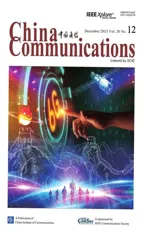Deep Learning Based Signal Detector for OFDM Systems
2023-12-10GuangliangPanWeiWangMingleiLi
Guangliang Pan ,Wei Wang,* ,Minglei Li
1 Key Laboratory of Dynamic Cognitive System of Electromagnetic Spectrum Space,Ministry of Industry and Information Technology,College of Electronic and Information Engineering,Nanjing University of Aeronautics and Astronautics,Nanjing 211106,China
2 College of Control Science and Engineering,China University of Petroleum(East China),Qingdao 266580,China
Abstract: In this paper,we propose a novel deep learning (DL)-based receiver design for orthogonal frequency division multiplexing (OFDM) systems.The entire process of channel estimation,equalization,and signal detection is replaced by a neural network(NN),and hence,the detector is called a NN detector (N2D).First,an OFDM signal model is established.We analyze both temporal and spectral characteristics of OFDM signals,which are the motivation for DL.Then,the generated data based on the simulation of channel statistics is used for offline training of bi-directional long short-term memory(Bi-LSTM)NN.Especially,a discriminator (F) is added to the input of Bi-LSTM NN to look for subcarrier transmission data with optimal channel gain(OCG),which can greatly improve the performance of the detector.Finally,the trained N2D is used for online recovery of OFDM symbols.The performance of the proposed N2D is analyzed theoretically in terms of bit error rate(BER)by Monte Carlo simulation under different parameter scenarios.The simulation results demonstrate that the BER of N2D is obviously lower than other algorithms,especially at high signal-to-noise ratios(SNRs).Meanwhile,the proposed N2D is robust to the fluctuation of parameter values.
Keywords: channel estimation;deep learning;OFDM;optimal channel gain;signal detection
I.INTRODUCTION
1.1 Background and Motivation
As one of the most beloved technologies in the fifth generation (5G) [1] system,orthogonal frequency division multiplexing (OFDM) is mainly applied to counter spectrum selective fading in wireless channels[2].Meanwhile,OFDM is also widely used in cognitive radio networks(CRN)[3,4].OFDM has the mode of multi-subcarrier parallel transmission,which makes it has excellent performance reducing intersymbol interference (ISI) [5].Similarly,the presence of cyclic prefix(CP)has contributed to fight against ISI and intercarrier interference (ICI) [6].Despite OFDM has many merits,it also suffers from multipath effects and other disturbances (e.g.,doppler shift [7],high peak average power ratio(PAPR)[8]),which brings certain challenges to receiver signal recovery.Channel state information (CSI) is an essential factor in addressing these challenges.Both coherence detection and demodulation require the support of CSI in OFDM systems.In general,the CSI can be estimated by means of pilots prior to the detection of OFDM symbols.With the estimated CSI,OFDM symbols can be recovered at the receiver[9].Only by adopting a suitable channel estimation strategy for OFDM systems can the receiver detect the OFDM signal with a lower bit error rate(BER)and,as a result,complete the entire process of high-quality signal recovery[10,11].
In recent years,deep learning (DL),a fundamental technology in artificial intelligence,has garnered the attention of numerous researchers[12].It has demonstrated significant practical applications in fields such as image processing and speech recognition [13,14].Furthermore,it is progressively making inroads into the realm of wireless communication,offering an initial reference solution to address challenges within the wireless communication domain[15,16].For us,delving deep into and analyzing how DL can resolve the OFDM signal detection problem,harnessing the potentially potent learning capabilities of DL,and enhancing the quality of wireless communication,represent a compelling and practical endeavor.
1.2 Related Work
Research on channel estimation and signal detection has always been a focus of researchers.Traditional estimation methods,such as least squares (LS) [17]and minimum mean-square error (MMSE) [18],have been widely used in signal detection of OFDM systems.Although the LS method does not require prior knowledge of the channel’s statistical properties,its estimation accuracy is limited.These methods rely on mathematical channel models,which are usually defined as linear and Gaussian distributions.The authors in[19]proposed novel LS and MMSE-based interference alignment schemes that adaptively design beamformers by relying on the availability of imperfect CSI and knowledge of the channel estimation error variance in advance.The authors in[20]proposed a hard-decision-based detection(HDD)scheme and a soft-decision-based detection (SDD) scheme,respectively,to detect non-contiguous OFDM symbols without the information of the spectrum synchronization.In [21],the authors proposed a robust pilot insertion technique (PIT) and three corresponding blind pilot detection techniques (PDTs).These methods depend on pilot information and the detection process is more complicated.Moreover,at the receiving end,due to the presence of pilot signals,the ideal channel estimation cannot be completed.Even if perfect channel estimation can be performed,channel compensation during signal demodulation amplifies the noise signal.
There are several reasons why DL is so popular: (i)DL is a deep neural network (DNN) model by datadriven.In practical application,it is robust to the physical deficiency of the system;(ii) Different from the traditional method of complex design,DL uses neural network (NN) to replace the complex design process.With these advantages,DL is introduced into the physical layer,which provides an effective method to improve the accuracy of signal detection[22].In[9],a deeper version of artificial NN (ANN) was used to counter nonlinear distortion and interference in wireless channel characteristics and frequency selectivity to realize end-to-end channel estimation and symbol detection.This method adopts the deep version of ANN to complete channel estimation and signal detection,the detection performance is mediocre.In [23],the authors quantized the channel estimation and signal detection of the OFDM receiver and replaced them with a DNN and a self-encoder,respectively.This algorithm increases the design complexity and does not enable end-to-end learning.The authors in [24]proposed a sequence detection method based on long short-term memory(LSTM),and verified its effectiveness by a chemical communication platform.In[25],we proposed an OFDM signal detection method based on LSTM.This method only uses ordinary LSTM network,and ignores the influence of data on the detection performance of the NN.In[26],the authors used deep reinforcement learning (DRL) to investigate the joint design of transmit beamforming matrix at the base station and the phase shift matrix at the reconfigurable intelligent surface(RIS).In[27,28],the authors used the convolutional neural network(CNN)to complete the design of the OFDM receiver.In [29],the authors processed the signal block-by-block,dividing the receiver into a channel estimation subnet and a signal detection subnet,each replaced by a DNN,and design the OFDM receiver in a model-driven manner.However,the design of using multiple NNs not only increases the training cost but also makes it difficult to break through the performance bottleneck.The work in [30] presented a PAPR reducing network based on the autoencoder architecture of the DL.The DL adaptively determines the constellation mapping and symbol mapping on each subcarrier,so as to jointly minimize the BER and the PAPR of the OFDM system.These efforts ignore the impact of data quality.
1.3 Contributions
To address these issues,we present a new DL-based signal detector in OFDM systems.The main contributions of this paper are summarized as follows:
· We investigate signal detection problem by jointly exploring both temporal and spectral correlation characteristics of OFDM signals.
· We propose a novel receiver design for OFDM systems based on DL denoted as NN detector (N2D).The proposedN2Das a black box replaces the channel estimation,equalization and symbol detection process of OFDM systems,turning it into a single operation.In particular,the discriminator(F)is added to the input of bidirectional LSTM (Bi-LSTM) NN in the offline training process of theN2D,which is used to observe the historical data and choose the subcarrier OFDM symbols with the optimal channel gain(OCG)to realize training data enhancement.In this way,the training complexity of detectorN2Dcan be reduced,and the performance of signal detection can be improved.
· We evaluate the proposedN2Dunder various parameter configurations and our experiment results show that the BER of the proposedN2Dis significantly lower than that of LS,MMSE,and LSTM algorithms.We find that the proposed detector is less sensitive to parameter changes,which indicates that theN2Dhas strong robustness and is more suitable for complex and changeable wireless communication environment.
The remainder of the paper is organized as follows.In Section II,we introduce the OFDM transmitted signal,channel and received signal.A novel signal detectorN2Dbased on DL in OFDM systems is proposed in Section III.In Section IV,we use the Monte Carlo simulation experiments in different scenarios to comprehensively evaluate the performance of the proposedN2D.Finally,conclusion and discussion are provided in Section V.
II.SYSTEM MODEL
2.1 Transmitted Signal
Based on Figure 1,we consider an OFDM system with parallel transmission viaNsubcarriers,where the transmitted symbols D of sequence lengthNconsists of data symbols and pilot symbols D=[D0,D1,...,DN-1]T.In practical OFDM systems,adding pilot symbols in subcarriers is helpful for CSI estimation and synchronous transmission.The transmitted symbols are mapped to constellations by modulation (e.g.,quadrature phase shift keying (QPSK)or 16 quadrature amplitude modulation (16QAM)).The modulation process can be implemented by using anN-point inverse FFT(IFFT)algorithm.Its output during then-th OFDM block can be written as d(n)=AID(n),where A is the normalized FFT matrix CN×N,and hence,AIis the IFFT matrix[31].Then,one bright spot is the insertion of a CP of lengthNcp,no less than the channel maximum experimental spread (Ch),into the transmit signal.Therefore,the total length of OFDM symbols isNT=N+Ncpin continuous transmission forTseconds.Then,the complex baseband OFDM symbol is upsampled,filtered and up-converted to a radio frequency (RF) before transmission through the antenna[32].
2.2 Channel and Received Signal
The OFDM transmitted signal enters the front end of the receiver through wireless channel,the sampling period isTs=T/NT.The channel is considered to consist ofCh+1 independent multipath components each of which has a gainhm~CN(0,)and delaym×Ts,wherem∈{0,1,...,Ch}.So,the received signal is represented in the time domain as
where h is channel matrix,⊗is cyclic convolution,y,r∈CN×1,r~CN(0,) is the additive white Gaussian noise(AWGN).Then,the received sequence after removing the CP and applying the FFT is represented in the frequency domain as[33]
where⊙represents multiply element by element,Y,H,D,R are the FFT of y,h,d,r,respectively.H represents the channel frequency response(CFR)
any element of H is defined as
The diagonal elements of H are highly correlated.Therefore,the correlation coefficient of adjacent elements can be defined as[32]
The transmitted signal reaches the equalizer after FFT,and then carries out coherent maximum likelihood detector(MLD),which can be expressed as[31]
To complete signal detection,we can consider replacing H in Eqs.(8) and (9) with an estimated version ˆH.Another possible method to implement the detector is to equalize Y,and then use a symbol-by-symbol coherent MLD.A single tap frequency-domain zero forcing equalizer can be used,the estimatedk-th symbol can be expressed as
We assume that an OFDM system does not have ISI or ICI,but this is not possible in a practical system.Moreover,the design of detector does not necessarily require the explicit knowledge of H under some special circumstances,such as[34].However,its BER is very sensitive to the channel variations.
III.PROPOSED N2D DETECTOR
3.1 Analysis of Signal Model
We established a signal model for OFDM system in Section II.It is worth noting that we will find some interesting things about this model,which will be very helpful for us to propose new ideas.It mainly includes the following aspects:
Correlations in time domain and freguency domain.The correlation analysis method mentioned in[35]is used to analyze the correlation in the time domain and frequency domain of OFDM signals.Specifically,we define two random variablesOandQ,whose sample means areµOandµQ,sample standard deviations areσOandσQ,and the correlation coefficientρO,Qcan be expressed as
wherecovis the covariance operator.This coefficient ranges between-1 and 1,extreme values indicatingOandQare(inversely)fully correlated.In general,the correlation is considered high when the absolute value of the coefficient is closed to 1.According to Figure 1,
we can consider 2-D OFDM symbols as a generalized representation ofxin the time and frequency domains.From the signal’s point of view: (i) Each subcarrier corresponds to a different frequency point;(ii)We define a matrix X∈CF×T,whoseFdenotes the indices of frequency points andTdenotes the indices of time slots;(iii) Each matrix elementxf,t,f∈{1,...,F},t∈{1,...,T},represents the OFDM transmitted symbols on thef-th frequency point in thet-th time slot[36].Two time-domain variablesx.,i,i∈{1,...,T}andx.,j,j∈{1,...,T}are selected to correspond to random variablesOandQin Eq.(11),respectively,and the correlation coefficientρO,Qis shown in Figure 2.Different from Gaussian noise in Figure 2a,we note that the time domain correlation of transmitted symbols in Figure 2b is significantly higher than that in Figure 2a.Similarly,two frequent-domain variablesxi,.,i∈{1,...,F}andxj,.,j∈{1,...,F}are selected to correspond to random variablesOandQin Eq.(11),respectively,and the correlation coefficientρO,Qis shown in Figure 3.We note that the frequency domain correlation of transmitted symbols in Figure 3b is significantly higher than that in Figure 3a.
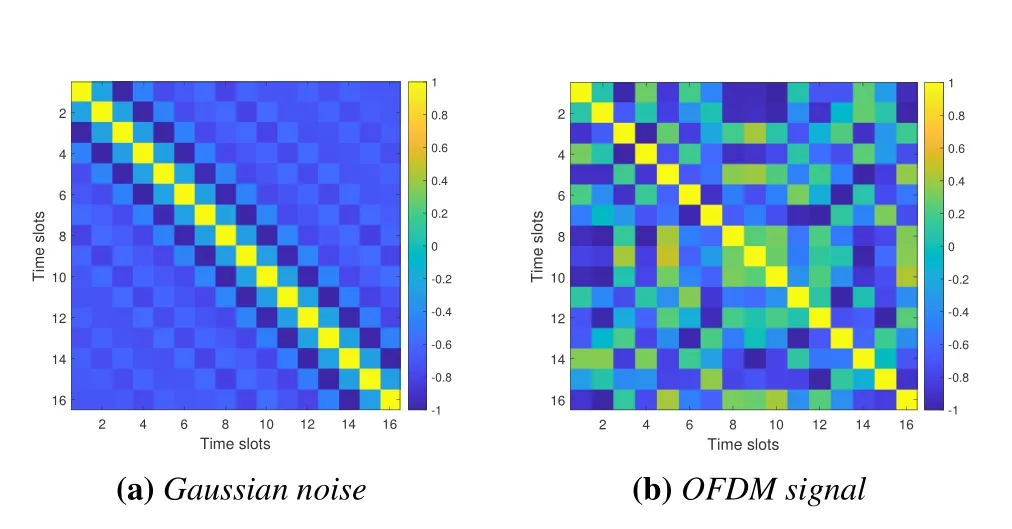
Figure 2.Correlations in the time domain.
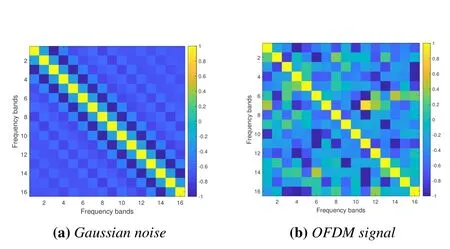
Figure 3.Correlations in the frequency domain.
Highly correlated channel matrix.In the frequency domain,the frequency selective (FS) channel matrix is a diagonal matrix [37].However,for a doubly-selective (DS) channel OFDM system,the channel matrix is a full matrix due to the influence of ICI [38].The differences of adjacent channel matrices are shown in Figure 4a.Each row of squares representsNsending subcarriers and each column of squares representsNreceiving subcarriers in Figure 4b.In order to explain the interference relationship between carriers,we define the intensity of interference between two subcarriers asG=φ·1/g,wheregdenotes the distance of an interval between two subcarriers.With constantφ,Ggradually decreases asgincreases.According to the above analysis,the channel matrix has a high correlation.
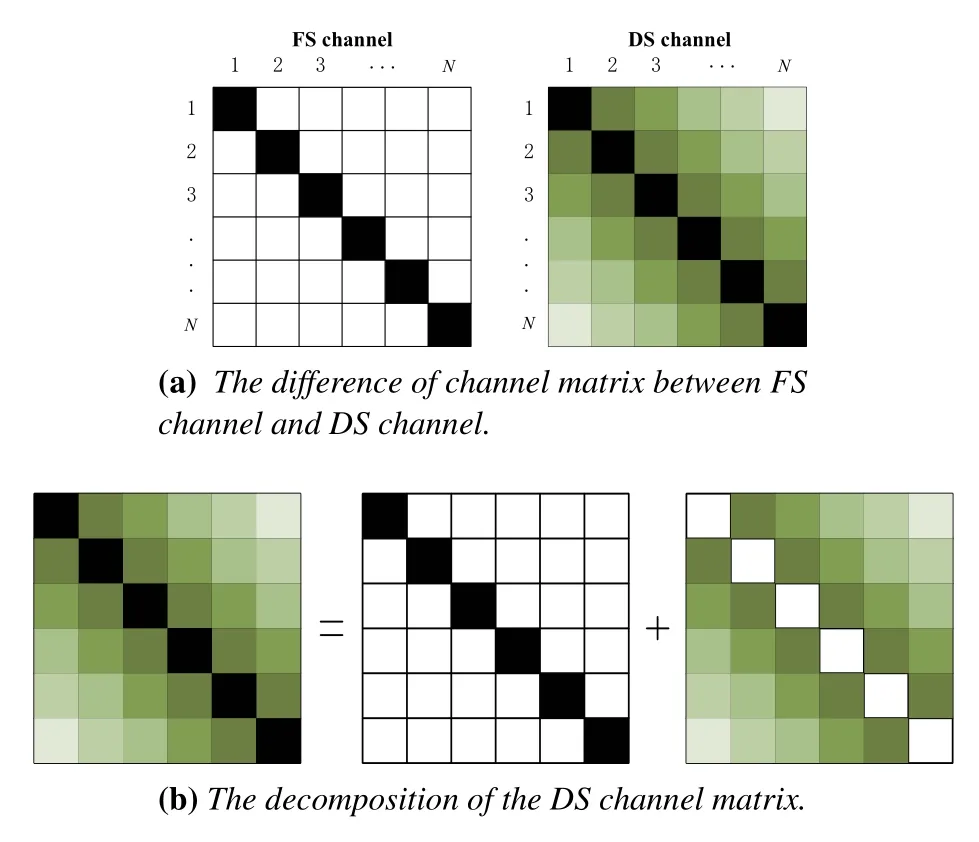
Figure 4.The channel matrix H in the frequency domain between receiver and transmitter. The black squares represent independent,identically distributed Gaussian random variables. The green squares represent the interference coefficients φ between adjacent subcarriers,and the depth of color represents the intensity of interference between subcarriers.
After the above analysis of several aspects of the characteristics of the signal model,there are several critical issues:
· OFDM signals have a correlation in the time domain and frequency domain.Although it is a weak correlation.It provides favorable conditions for the design of signal detector.
· The channel matrix H is highly correlated,which is detrimental to some signal detection methods such as[39].
3.2 Proposed N2D
Different from the ANN and CNN,recurrent neural network(RNN)has great advantages in processing sequence data.As an improved RNN,the Bi-LSTM NN overcomes the problem of gradient explosion and disappearance of the original RNN.With the increase of the number of hidden layers and recurrent memory units,the depth of NN model becomes deeper,and the learning ability also becomes stronger.In order to solve the problems that existing researches rely excessively on pilot,OFDM is seriously affected by ISI and ICI,the design based on NN is complicated and the BER is sensitive to channel change,a design of detectorN2Dbased on DL is proposed.
Figure 5 illustrates how the design of detectorN2Dis implemented.DetectorN2Dis used as a black box instead of channel estimation,equalization and signal detection.The implementation of the detector is divided into two processes: offline training and online testing.Because of considering the complexity of the NN model,the computational overhead is reduced and model training accuracy is improved.Specifically,a discriminatorFis added to the input of Bi-LSTM,which adaptively selects the subcarriers with the OCG.We define the channel gain of then-th subcarrier intth time slot as functionft(n),and the OCG subcarrier of sampledTtime slot can be expressed as

Figure 5.The design of detector N2D.
wheren∈[1,2,...,N],t∈[1,2,...,T].Through Eq.(12),the high-dimensional characteristic data with relatively low Kullback-Leibler (KL) divergence can be obtained.Therefore,theFis used to look for the subcarrier transmitted symbols with the OCG,which will be used as thepgroups of training data,wherex.represents the OFDM symbol,y.represents the label value.Specifically,the Bi-LSTM NN hasLlayers,and the first layer is denoted as the input layer.Then,the Bi-LSTM model completes the offline training.Finally,the trained Bi-LSTM model is used for online channel estimation and signal detection of the OFDM receiver.
1)Offlinetraining
First,the OFDM training data flows through the forgetting gate of Bi-LSTM network,which determines information is retained in the output st-1and unit state ct-1at the previous moment to the current moment ct.The input of the forgetting gate is the output st-1of the previous moment and the input xtof the current moment,and the output of the current moment of the internal NN is obtained as[40]
whereσrepresents sigmoid active function,which is
Wfand bfrepresent the weight matrix and bias matrix of the forgetting gate,respectively.Then,the data flows enter the input gate,which determines the information of the input xtat the current moment is retained to the current state unit ct,and the sigmoid function and tanh function are used to realize the update of the state unit ct.The formula is expressed as
whereλrepresents tanh active function,which is
Wiand birepresent the weight matrix and bias matrix of the input gate,respectively.Wcand bcrepresent the weight matrix and bias matrix of alternative update units,respectively.The updated cell state ctis
where*represents the dot product between elements.After information is selectively remembered and updated,it finally enters into the output gate.It completes two tasks: Filtering information and getting an initial output;The unit state ctis selectively output to the next moment.The formula is expressed as
where Woand borepresent the weight matrix and bias matrix of the output gate,respectively.The above is the forward propagation process of the whole model.As a universal error function,the mean square error(MSE) is used to measure the difference betweenandDi:
Assuming that the layerlhasMlnodes,the overall cost of this model in the training process can be calculated as
where the latter part represents the computing results of the square sum ofin the network,represents the weight between theinode in layerland thejnode in layerl+1 of the NN and the attenuation coefficientη.Let U={W,b},the objective function is
In order to get the optimal U,we use the gradient descent algorithm:
whereW(s) andb(s) denote weight and bias ofs-th training.αis the learning rate.
2)Onlinetesting
After the training of the model,the trainedN2Ddetector is used to detect the online signal of the receiver in OFDM systems.Similarly,the test sequence is generated online through an OFDM system.We randomly inputP-pgroups of test sequence{(xn,p+1,yn,p+1),...,(xn,P,yn,P)}into the trained model and get the output.So,the error between the estimated value and the real value is
The Monte Carlo simulation is used to count the number of estimated values withφ=0 from real values,and then the BER is calculated as
wherekrepresents the statistic of the estimated value of the model is equal to the true value.Finally,we summarize the implementation process of the designedN2Ddetector in Algorithm 1.
IV.EXPERIMENTAL EVALUATION
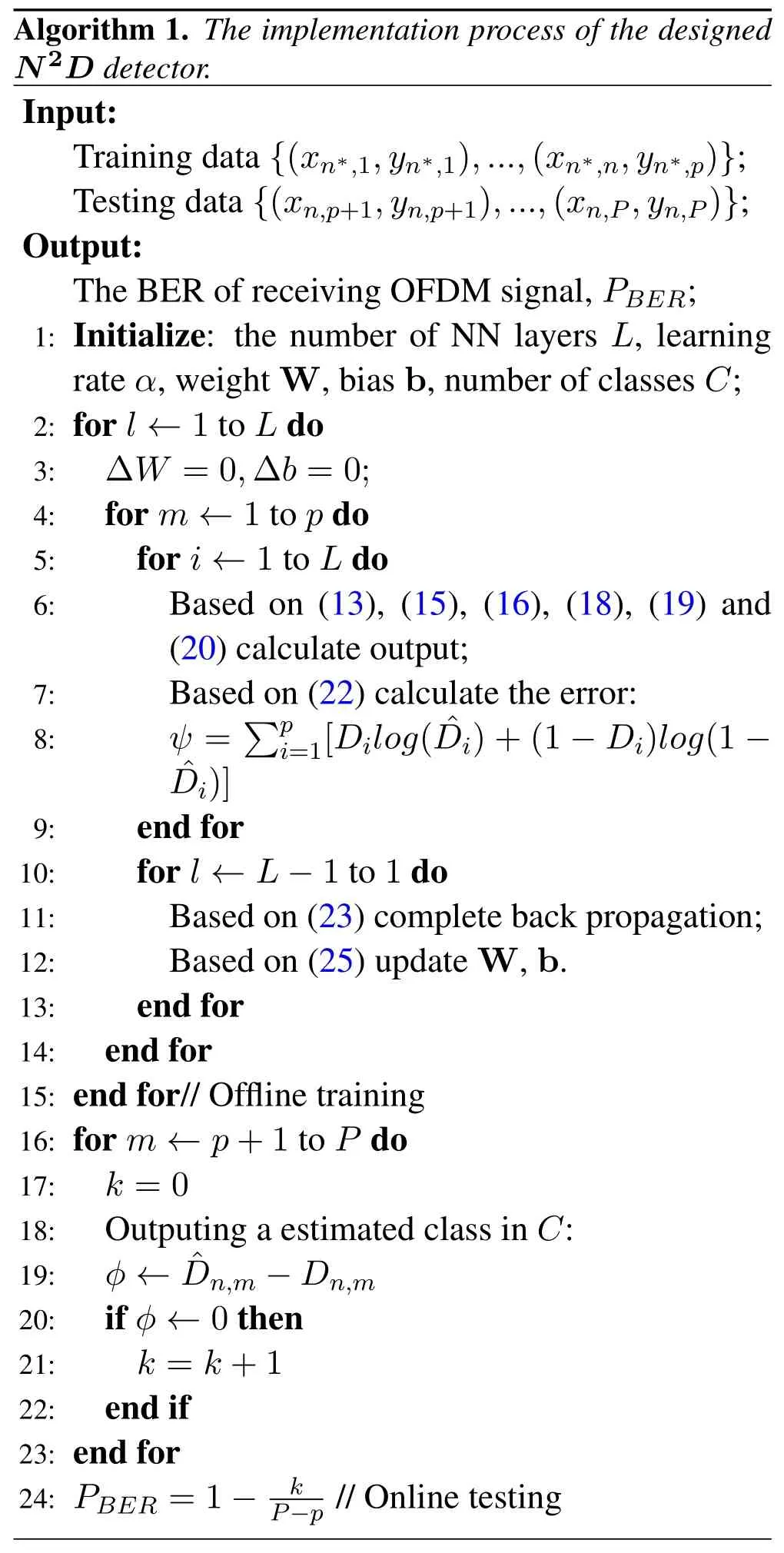
We have conducted several experiments to demonstrate the effectiveness of the proposedN2Dfor channel estimation and signal detection in OFDM systems.The OFDM sequence data generated by simulation is used for Bi-LSTM model training,and simulation parameters are shown in Table 1.The proposedN2Dand the traditional algorithm are tested online under different signal-to-noise ratios (SNRs) to compare their performance,and the BER is used for performance index.It can be seen from these experiments that the BER of the proposedN2Din signal detection is significantly lower than other algorithms,which indicates that the proposedN2Dhas stronger robustness.In the simulation experiment,for an OFDM system,64 subcarriers and CP with a length of 16 are used,and 2 OFDM blocks (1 OFDM block is composed of a set of OFDM data and a set of pilot data)are used as the dataset.The ratio of the training set and the validation set is 4:1.The wireless channel model uses the conventional 3GPP channel(the Riley decay channel can also be used),the number of paths is 20,and typical urban channels with maximum delay 16 sampling period are used.Now,let’s start our interesting experiments.
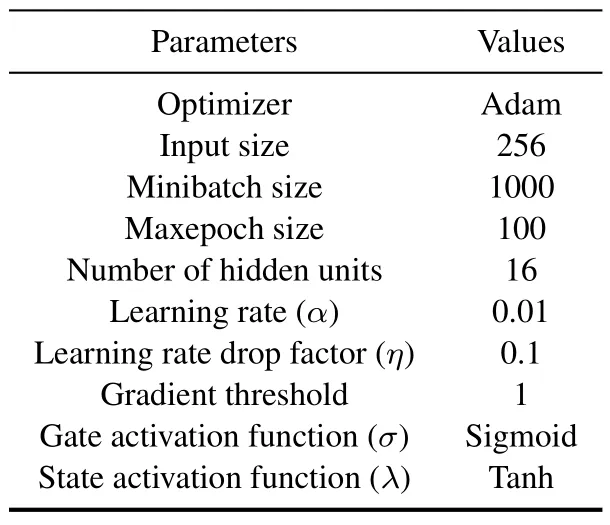
Table 1.Simulation parameters.
4.1 Comparison and Analysis of Pilot Numbers
In this experiment,we consider the effect of the number of pilots on the detection performance of the proposedN2D.Under the premise of ensuring the other factors of the model remain unchanged,the number of pilots is set as 8 and 64,respectively.The performance comparisons between theN2Dand other algorithms are shown in Figure 6.From the Figure 6,when the number of pilots is 8,we can observe the BER curves of the LS and MMSE algorithms are almost same under different SNR.Meanwhile,when the SNR changes from 15dB to 20dB,the detection performance of the LS and MMSE algorithms does not change significantly.On the contrary,the detection accuracy of the proposedN2Dis greatly improved.In addition,although the detection performance of the LSTM based method is improved,it is still not better than the proposedN2D.
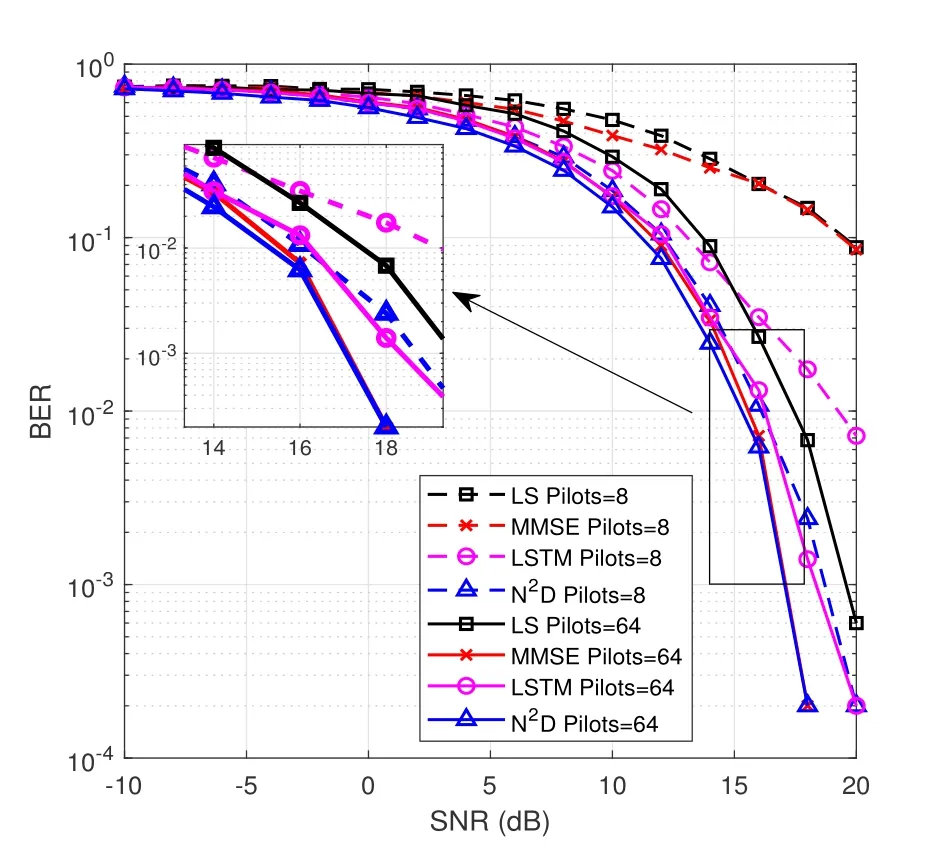
Figure 6.The BERs comparison curve of the proposed N2D and traditional algorithms under different pilots.
When the number of pilots exceeds 64,the BER of the proposedN2Dis also lower than that of LS,MMSE,and LSTM-based algorithms.In particular,the MMSE has comparable performance to proposedN2D.These changes indicate: (i) The performance of the LS and MMSE algorithms is greatly influenced by pilot number,which is positive correlation;(ii)The LS does not use the prior statistics of channel,and its performance is worst;(iii)The memory ability of the LSTM for data features is significantly lower than that of the Bi-LSTM;(iiii) The proposedN2Dhas certain robustness to the variation of the pilot number.Another concern is that low pilots do not occupy too much position to improve the transmission capacity of OFDM symbols.In other words,the reduction of pilot number will improve the throughput of the OFDM system.It can be seen from Table 2 that the SNRs of proposedN2Dare lower than other three algorithms at BER of 10-2and 10-3,respectively.In particular,when the pilot number is 64,the SNRs of the LSTM are higher than MMSE algorithm at BER of 10-2and 10-3,respectively.It shows that the NN based method is not necessarily superior to traditional algorithms.Therefore,the overall performance of theN2Dis better than traditional algorithms and the LSTM when facing the influence factor of the pilot number.
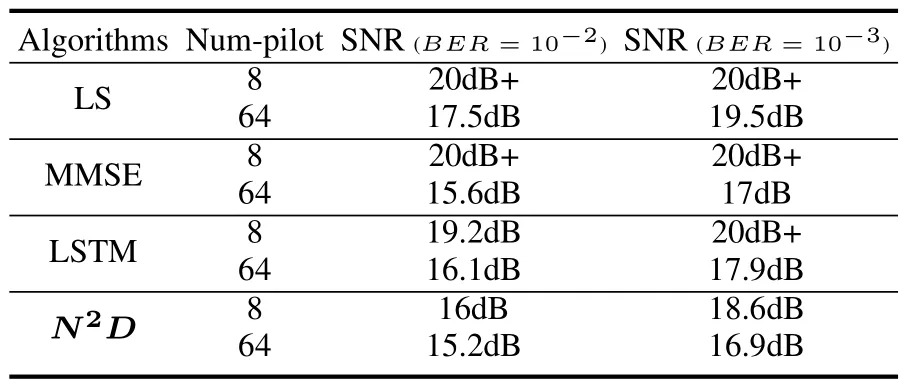
Table 2.Comparison of BERs for different pilot numbers.
4.2 Comparison and Analysis of CP
The CP insertion can effectively counter ISI in OFDM signal transmission,but it will also increase the energy and time cost of transmission.Figure 7 illustrates the BER variation of the proposedN2Dand traditional algorithms under different SNRs when CP exists and does not exist,respectively.
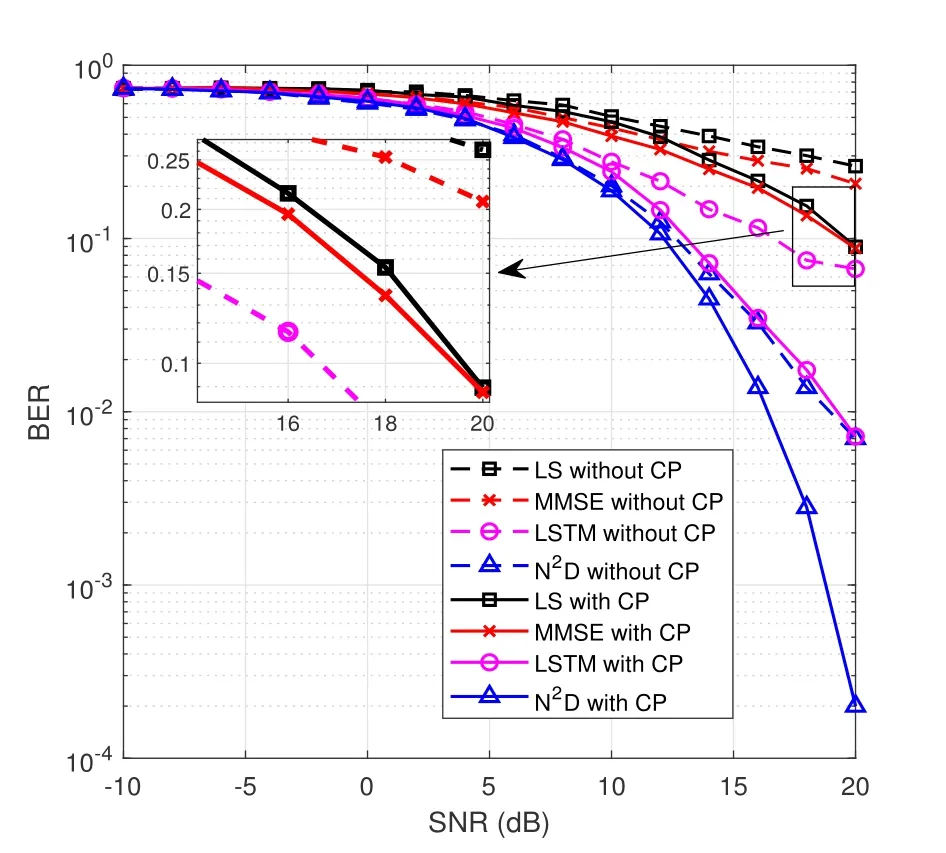
Figure 7.Comparison of algorithms performance with and without CP.
From the Figure 7,neither LS nor MMSE can effectively estimate channel,and the estimation ability of the LSTM is weak.The accuracy of LS tends to be saturated and MMSE also still has a large BER when SNR is over 15 dB.Although LSTM has been improved,the BER is still high.However,the proposedN2Dstill works better.Besides,By observing the degree of BER variation of the algorithms,it can be found that the performance fluctuations of LS and MMSE are less affected by CP,while the performance fluctuations of the LSTM and proposedN2Dare more affected by CP when the SNR is 20 dB.However,the BER of the proposedN2Dis one order of magnitude lower than that of the LSTM based method.This result indicates that the proposedN2Dhas learned the deeper wireless channel characteristic information of the OFDM systems.
4.3 Comparison and Analysis of Different Modulation Modes
It is well known that different modulation modes have different effects on signal transmission in wireless communication systems.Different modulation modes are considered to illustrate the reliability and intelligence of the proposedN2D.The QPSK and 16QAM are selected.The same parameters are used,and the performance comparisons of various algorithms are presented in Figure 8.As shown in Figure 8,the BER of theN2Dis significantly lower than other algorithms under QPSK and 16QAM,respectively.Specifically,the BER of the proposedN2Dis 99.78%,99.77%,and 97.22% lower than that of LS,MMSE,and LSTM,respectively,for QPSK modulation at an SNR of 20dB.Similarly,for 16QAM modulation at an SNR of 20dB,the BER of the proposedN2Dis 91.85%,92.08%,and 70.03% lower than that of LS,MMSE,and LSTM,respectively.
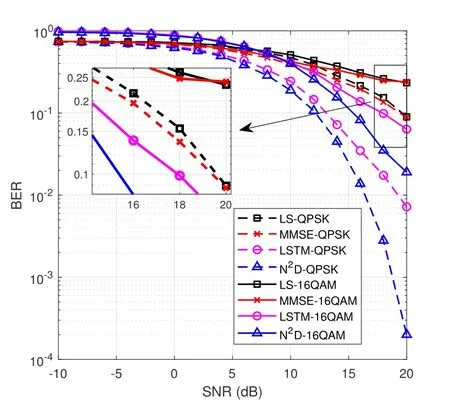
Figure 8.BER curves of proposed N2D and other algorithms in different modulation modes.
Table 3 shows that the SNR size comparison of the algorithm in different modulation modes under the premise of the same BER.It is worth noting that the SNR of proposedN2Dis obviously lower than that of other algorithms under the same BER in the QPSK modulation mode.The above show that deep learning can still learn feature information even in the face of more complex modulations.Meanwhile,the learning ability of theN2Dis better than that of LSTM.Besides,the detection performance of LS and MMSE algorithms is less affected by the modulation mode,but the detection accuracy is low.The BER of theN2Dbecomes progressively larger with the modulation order increases.The reason is that the increase of modulation order makes the constellation points increase,which will increase the difficulty of the Bi-LSTM model learning.Besides,the higher the modulation order,the faster the data transmission rate,which will lead to the worse signal detection performance.
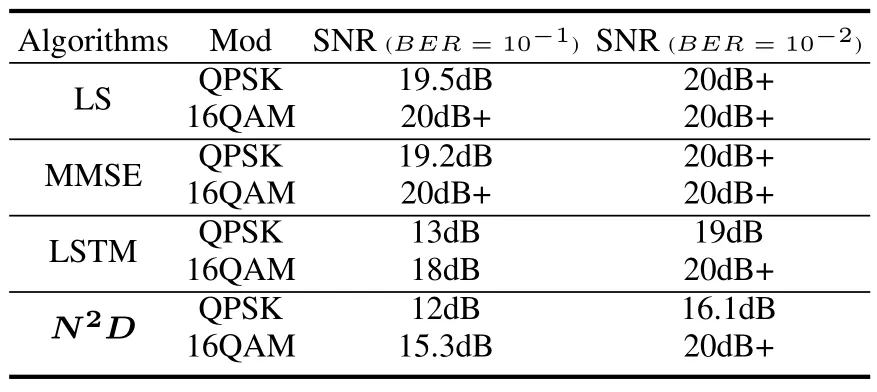
Table 3.BER performance under different modulation methods.
4.4 The Robustness Analysis of Proposed Algorithm
In the previous experiments,the training set and the testing set adopt the same parameters,but in the actual OFDM system,the wireless channel environment is complex and changeable,which has higher requirements on the stability of the system.When the parameters of the test set (such as timing delay,the number of paths) change,the robustness analysis of proposedN2Dis an important factor to verify its effectiveness.In this experiment,the parameter of path number is considered.Figure 9 illustrates the variation of BER of the proposedN2Dunder different number of paths.From the figure,the performance of the proposedN2Dis not significantly affected when the statistics of wireless channel model change,which indicates that theN2Dhas strong robustness.
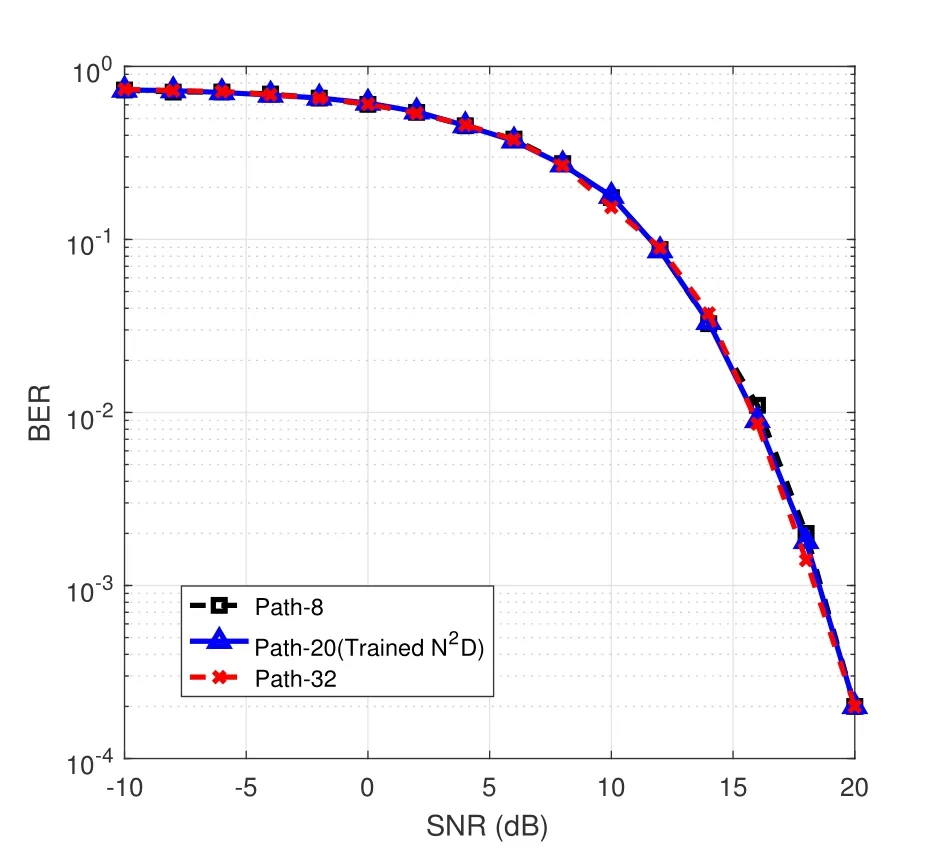
Figure 9.BER performance for different number of paths.
V.CONCLUSION
In this paper,we have proposed a novel signal detector based on data-driven DL in OFDM systems.Especially,a discriminator,denoted asF,enablesN2Dto acquire training data with optimal channel gain(OCG)to maximize its learning capacity.Unlike LSTM,Bi-LSTM exhibits a superior ability to understand time series data.The proposedN2Dexhibits enhanced robustness to pilots,modulation modes,and timing delays when compared to conventional OFDM detection methods.Extensive simulation results demonstrate that the detection performance ofN2D,under varying pilot conditions,the presence of CP,and different modulation modes,significantly outperforms traditional algorithms.Furthermore,it maintains good detection performance even when the number of actual paths changes.This is attributed to the underlying capability of Bi-LSTM,which extracts both known and unknown hidden features of OFDM signals.
This study aims to showcase the unlimited potential of DL in addressing fundamental challenges at the physical layer of wireless communication networks.Moreover,DL is evolving rapidly from a data-driven paradigm to a data-model-driven approach,which will be the primary focus of our future research efforts.
ACKNOWLEDGEMENT
This work was supported in part by the National Natural Science Foundation of China No.62001220,the Natural Science Foundation of Jiangsu Province BK20200440,the Fundamental Research Funds for the Central Universities No.1004-YAH20016,No.NT2020009.An earlier work of this paper was presented at IEEE PIMRC 2021[25].
杂志排行
China Communications的其它文章
- Spatial Modeling and Reliability Analyzing of Reconfigurable Intelligent Surfaces-Assisted Fog-RAN with Repulsion
- An Efficient Federated Learning Framework Deployed in Resource-Constrained IoV:User Selection and Learning Time Optimization Schemes
- ELM-Based Impact Analysis of Meteorological Parameters on the Radio Transmission of X-Band over the Qiongzhou Strait of China
- IoV and Blockchain-Enabled Driving Guidance Strategy in Complex Traffic Environment
- Multi-Source Underwater DOA Estimation Using PSO-BP Neural Network Based on High-Order Cumulant Optimization
- Secure Short-Packet Transmission in Uplink Massive MU-MIMO Assisted URLLC Under Imperfect CSI
